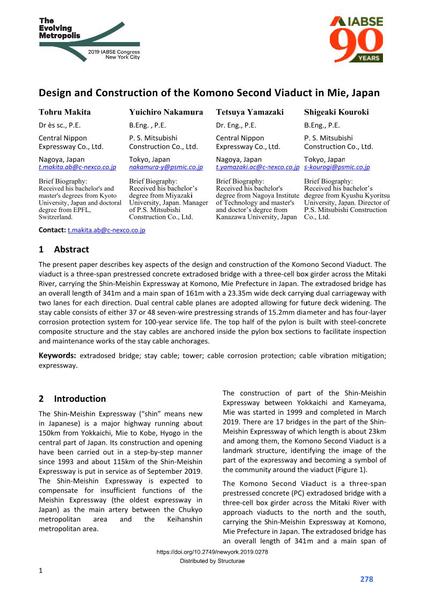Design and Construction of the Komono Secon Viaduct in Mie, Japan

|
|
|||||||||||
Bibliografische Angaben
| Autor(en): |
Tohru Makita
(Central Nippon Expressway Co.,Ltd.)
Yuichiro Nakamura (P. S. Mitsubishi Construction Co., Ltd.) Shigeaki Kouroki (Central Nippon Expressway Co.,Ltd.) Tetsuya Yamazaki (P. S. Mitsubishi Construction Co., Ltd.) |
||||
|---|---|---|---|---|---|
| Medium: | Tagungsbeitrag | ||||
| Sprache(n): | Englisch | ||||
| Tagung: | IABSE Congress: The Evolving Metropolis, New York, NY, USA, 4-6 September 2019 | ||||
| Veröffentlicht in: | The Evolving Metropolis | ||||
|
|||||
| Seite(n): | 278-283 | ||||
| Anzahl der Seiten (im PDF): | 6 | ||||
| DOI: | 10.2749/newyork.2019.0278 | ||||
| Abstrakt: |
The present paper describes key aspects of the design and construction of the Komono Second Viaduct. The viaduct is a three‐span prestressed concrete extradosed bridge with a three‐cell box girder across the Mitaki River, carrying the Shin‐Meishin Expressway at Komono, Mie Prefecture in Japan. The extradosed bridge has an overall length of 341m and a main span of 161m with a 23.35m wide deck carrying dual carriageway with two lanes for each direction. Dual central cable planes are adopted allowing for future deck widening. The stay cable consists of either 37 or 48 seven‐wire prestressing strands of 15.2mm diameter and has four‐layer corrosion protection system for 100‐year service life. The top half of the pylon is built with steel‐concrete composite structure and the stay cables are anchored inside the pylon box sections to facilitate inspection and maintenance works of the stay cable anchorages. |
||||


